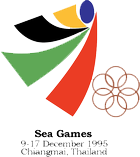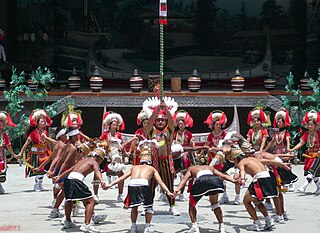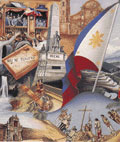This page is based on this
Wikipedia article Text is available under the
CC BY-SA 4.0 license; additional terms may apply.
Images, videos and audio are available under their respective licenses.

Southeast Asia or Southeastern Asia is a subregion of Asia, consisting of the countries that are geographically south of China and Japan, east of India, west of Papua New Guinea, and north of Australia. Southeast Asia is bordered to the north by East Asia, to the west by South Asia and the Bay of Bengal, to the east by Oceania and the Pacific Ocean, and to the south by Australia and the Indian Ocean. The region is the only part of Asia that lies partly within the Southern Hemisphere, although the majority of it is in the Northern Hemisphere. In contemporary definition, Southeast Asia consists of two geographic regions:
- Mainland Southeast Asia, also known historically as Indochina, comprising parts of Northeast India, Vietnam, Laos, Cambodia, Thailand, Myanmar, and West Malaysia.
- Maritime Southeast Asia, also known historically as Nusantara, the East Indies and Malay Archipelago, comprises the Andaman and Nicobar Islands of India, Indonesia, East Malaysia, Singapore, the Philippines, East Timor, Brunei, Christmas Island, and the Cocos (Keeling) Islands. Taiwan is also included in this grouping by many anthropologists.

The East Indies or the Indies are the lands of South and Southeast Asia. In a more restricted sense, the Indies can be used to refer to the islands of Southeast Asia, especially the Indonesian Archipelago and the Philippine Archipelago. The name "Indies" is derived from the River Indus and is used to connote parts of Asia that came under Indian cultural influence.
Indonesian is anything of, from, or related to Indonesia, an archipelagic country in Southeast Asia. It may refer to:

Filipinos are the people who are native to or identified with the country of the Philippines. Filipinos come from various ethnolinguistic groups that are native to the islands or migrants from various Asia Pacific regions. Currently, there are more than 175 ethnolinguistic groups, each with its own language, identity, culture and history. The modern Filipino identity, with its Austronesian roots, was influenced by Spain, China, and the United States.

The 1995 Southeast Asian Games, officially known as the 18th Southeast Asian Games, was a Southeast Asian multi-sport event held in Chiang Mai, Thailand from 9 to 17 December 1995. It was the first time that a non-capital city hosted the biennial sports event. Chiang Mai is the second Thai city to host the Southeast Asian Games after Bangkok. The games were opened and closed by Vajiralongkorn, the then-Crown Prince of Thailand. With the return of Cambodia, all ten members of the federation were present to compete in the SEA Games for the first time.

The Austronesian peoples or more accurately Austronesian-speaking peoples, are a group of various peoples in Southeast Asia, Oceania and East Africa that speak Austronesian languages. The nations and territories predominantly populated by Austronesian-speaking peoples are known collectively as Austronesia.

Sports in Indonesia are popular from both the participation and spectating aspect. Some popular sports in Indonesia are badminton, football, and the native Indonesian martial art Pencak Silat. Badminton is arguably Indonesia's most successful sport. Indonesia has won gold medals in badminton in every Olympic Games since the sport was first introduced to the Olympics in 1992 except in 2012 Summer Olympics. Indonesia is regularly a participating in Thomas Cup, Uber Cup, and Sudirman Cup Badminton championships. Indonesia is regularly participating in regional multi-events sport, such as Southeast Asian Games, Asian Games, and Olympic Games. In Southeast Asia, Indonesia is one of the major sport powerhouses in the region by winning the Southeast Asian Games 10 times since 1977.

The Spanish Expedition to Borneo, also known locally as the Castilian War, was a military conflict between Brunei and Spain in 1578.
Dialium excelsum is a species of flowering plant in the legume family, Fabaceae. It is native to the Democratic Republic of the Congo and Uganda. It is threatened by mining and forest clearing.
The Orang Laut language or Loncong, is one of the Malayan languages. It is one of several native languages of Orang Laut of the Bangka and Belitung islands in Indonesia, and may be two distinct languages.
Asian people or Asiatic people are people who descend from a portion of Asia's population.
Shariff Muhammed Kabungsuwan was the first Sultan of Maguindanao in the Philippines. A native of Johore in Maritime Southeast Asia, Kabungsuwan re-settled in Mindanao in the Philippines where he preached Islam to the native tribes around the region.
Indianisation may refer to:

Paradoxosomatidae, the only family in the suborder Paradoxosomatidea, is a family of flat-backed millipedes in the order Polydesmida. Containing nearly 200 genera and 975 species as of 2013, it is one of the largest families of millipedes. Paradoxosomatids occur on all continents except Antarctica, and can generally be distinguished by dorsal grooves on most body segments and a dumb-bell shaped gonopod aperture. Notable groups within the Paradoxosomatidae include the dragon millipedes of Southeast Asia, and the widely introduced Greenhouse Millipede Oxidus gracilis.
The Arab Malaysians consists of people of full or partial Arab descent who were born in or immigrated to Malaysia.

Indochina, originally Indo-China, is a geographical term which originated in the early nineteenth century and refers to the region today known as Mainland Southeast Asia, or the Indochinese Peninsula. The name refers to lands historically within the cultural influence of India and China, and physically bound by the Indian Subcontinent in the west and China in the north. It corresponds to the present-day areas of Cambodia, Thailand, Laos, Myanmar, Vietnam, and (variably) peninsular Malaysia and Singapore. The term was later adopted as the name of the colony of French Indochina.












